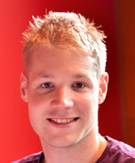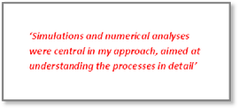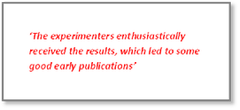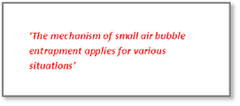 In this thesis various mechanisms by which droplets can deform, are resolved in detail, in both fundamental and industrial contexts. ‘Fluid dynamics is of prime importance in inkjet printing and Extreme Ultraviolet (EUV) lithography for example,’ Wilco Bouwhuis says. ‘Our simulations are aimed at understanding these processes in detail.’
In this thesis various mechanisms by which droplets can deform, are resolved in detail, in both fundamental and industrial contexts. ‘Fluid dynamics is of prime importance in inkjet printing and Extreme Ultraviolet (EUV) lithography for example,’ Wilco Bouwhuis says. ‘Our simulations are aimed at understanding these processes in detail.’
The first part of his thesis project, Wilco focused on small air bubble entrapment during drop impact, in which the inertia and the surface tension of the liquid acts against the deformation of the drop, minimizing the size of the entrained air bubble. Boundary Integral simulations show that there exists a maximal entrained bubble size for some impact velocity.

Wilco: ‘The mechanism of small air bubble entrapment applies for various situations: impact of a liquid drop onto a solid surface, impact of a liquid drop onto a (deep) pool, and impact of a solid sphere onto a pool. The sizes of the entrained air bubbles are quantitatively equal for the three cases.’
Early publications
The simulations and consequent theoretical models fitted experimental results astonishingly well. Wilco: ‘The experimenters enthusiastically received the results, which led to some good early publications and very nice collaborations with other institutes.’
Besides scientific interest, also leading companies welcomed the results. The development of EUV-lithography may benefit. Here small wavelength radiation results from liquid tin sheets, that is, deformed drops that are impacted by laser-pulse, resulting in the formation of plasma.

‘Here our expertise comes in handy,’ Wilco says. ‘Fluid dynamics is one of the vast expertises of companies. We collaborated on this line of research all along my PhD project with experts of ASML and OCÉ, supporting us with their expertise and help steering the research objectives towards appealing scientific and industrial results.’
Other covered subjects Wilco worked on, were the high-speed impact of a train of microdrops on a pool, instabilities at Leidenfrost drops, and pouring flows.
Aimed at understanding
‘Simulations and numerical analyses were central in my approach, aimed at understanding the processes in detail’, says Wilco. ‘This aspect I most love in performing scientific research.’

Notwithstanding this drive for research, Wilco plans his career in a different direction. ‘I will be starting as a teacher in mechanical engineering at a graduate school in this region,’ he says. ‘In the lectureship system here the themes of education and research will be practical in nature. I am looking forward to that.’
Teaching skills
Entering education was present from his master period on. ‘My PhD project was a once in a lifetime opportunity to contribute to scientific research. I am glad to have seized the opportunity,’ Wilco says. ‘During the PhD I was able to work on my teaching skills as well. For example, I enjoyed the information days we organized for the parents of freshman students, to show them the daily life of the students.’
Wilco benefited by working at the Physics of Fluids (PoF) group, as a part of the Mesa+ Institute. The work environment within our community is very good, as collaborations with colleagues within and from outside the group. Interaction with people from industry, and visiting conferences and summer schools, are intensely encouraged.’
